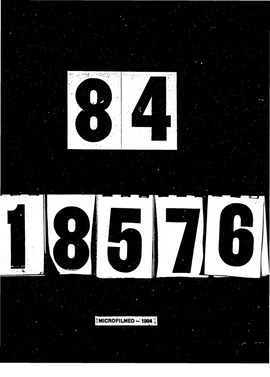| dc.contributor.author | Braun, Beth A., | en_US |
| dc.date.accessioned | 2013-08-16T12:29:03Z | |
| dc.date.available | 2013-08-16T12:29:03Z | |
| dc.date.issued | 1984 | en_US |
| dc.identifier.uri | https://hdl.handle.net/11244/5227 | |
| dc.description.abstract | All animals, acclimated at 20(DEGREES)C and LD 12:12, were subjected to a 3 hr control period of normoxic normocapnia in both media. Necturus was then exposed to aquatic hypercapnia of P(, CO(, 2)) = 20-130 mm Hg, and the P(, O(, 2)) of this solution elevated to that at the beginning of the control period (150 mm Hg). While none of the animals registered pulmonary CO(, 2) release during the control period, 6 out of the 16 did so during hypercapnia. This contribution of the lungs to overall gas exchange was, however, extremely small; it did not fall into a regular pattern in any animal. Thus, aquatic hypercapnia did not result in a shift in CO(, 2) release from gills and skin to lungs. | en_US |
| dc.description.abstract | In animals with more than one respiratory surface, gas exchange may be partitioned in response to several environmental factors. Both the relative importance of such variables and the physiological limitations to responding to them, as well as complex interactions among these forces, are in need of clarification. This study documents the hypercapnic response of both aerial and aquatic gas exchange in 4 species of the giant salamanders. Necturus maculosus is predominantly a 'water-breather', while Amphiuma tridactylum, Siren lacertina, and Siren intermedia can utilize well-developed lungs for aerial respiration. Of these, only Amphiuma is gill-less. | en_US |
| dc.description.abstract | In the other 3 species, aerial and aquatic gas exchange was measured in response to aerial (6% CO(, 2)) and aquatic (P(, CO(, 2)) = 40 mmHg) hypercapnia. CO(, 2) loss increased significantly across lungs and aquatic surface(s) in all 3 species; however, there was no accompanying change in overall CO(, 2) production (V(, CO(, 2))). Concomitant levels of O(, 2) consumption (V(, O(, 2))) indicate that CO(, 2) loss during experimental hypercapnia is sufficient to maintain the respiratory exchange ratio at control values; in some cases it exceeds this level, thereby including CO(, 2) from the imposed hypercapnia. Extracellular acidosis resulting from comparable levels of hypercapnia is uncompensated in Amphiuma means and Siren lacertina (Heisler et al., 1982). Thus, the capacity for increased pulmonary V(, CO(, 2)) is apparently not effective for regulating acid-base balance in these species. | en_US |
| dc.format.extent | ix, 53 leaves : | en_US |
| dc.subject | Biology, Animal Physiology. | en_US |
| dc.title | Aerial versus aquatic gas exchange in salamanders in response to environmental hypercapnia / | en_US |
| dc.type | Thesis | en_US |
| dc.thesis.degree | Ph.D. | en_US |
| dc.thesis.degreeDiscipline | Department of Biology | en_US |
| dc.note | Source: Dissertation Abstracts International, Volume: 45-05, Section: B, page: 1389. | en_US |
| ou.identifier | (UMI)AAI8418576 | en_US |
| ou.group | College of Arts and Sciences::Department of Biology | |
